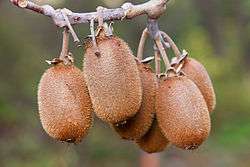Actinidia chinensis
Actinidia chinensis [1][2] is a fruit tree and medicinal plant [3] native to China. It is pollinated by bees.
Habitat

In its native habitat Actinidia chinensis grows in thickets, thick (oak) forests (e.g. Quercus aquifolioides, Quercus oxyodon, Quercus lamellosa), and light secondary forests and bushland. A. chinensis prefers slopes and likes also to grow in ravines, top heights of 200-230m, relative to the local microclimate. In Western gardens it may range 30 feet in all directions, making it unsuitable for all but the largest spaces unless pruned back hard at the end of every growing season.
Origin
The origin of Actinidia chinensis is supposed to be the northern Yangtze river valley. In China, Actinidia chinensis is nowadays dispersed in the entire southeast of the country.
Herbarium specimens, but not plants, were forwarded to the Royal Horticultural Society by the British plant hunter Robert Fortune, from which Jules Émile Planchon named the new genus in the London Journal of Botany, 1847. Charles Maries, collecting for Messrs Veitch noted it in Japan, but the introduction to Western horticulture was from E.H. Wilson, who sent seeds collected in Hupeh to Veitch in 1900.[4]
Uses

The fruits, the size of a walnut, are edible. It was first grown commercially in New Zealand,[4] where it has been superseded by Actinidia deliciosa, or Kiwifruit.
It is used in traditional Chinese medicine.[5]
| Wikimedia Commons has media related to Actinidia chinensis. |
References
- ↑ "Actinidia chinensis". Integrated Taxonomic Information System. Retrieved 2007-10-13.
- ↑ Actinidia chinensis at USDA PLANTS Database
- ↑ "Actinidia chinensis". Plants For A Future. Archived from the original on 2008-10-07.
- 1 2 Alice M. Coats, Garden Shrubs and Their History (1964) 1992, s.v. "Actinidia".
- ↑ Zhou, J.; Xie, G.; Yan, X. (2011). Encyclopedia of Traditional Chinese Medicines - Molecular Structures, Pharmacological Activities, Natural Sources and Applications: Vol. 5: Isolated Compounds T—Z, References, TCM Plants and Congeners. Springer. p. 353. ISBN 9783642167416. Retrieved 2014-10-10.
See also
| Wikispecies has information related to: Actinidia chinensis |
